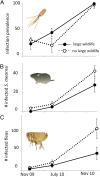Declines in large wildlife increase landscape-level prevalence of rodent-borne disease in Africa
- PMID: 24778215
- PMCID: PMC4024866
- DOI: 10.1073/pnas.1404958111
Declines in large wildlife increase landscape-level prevalence of rodent-borne disease in Africa
Abstract
Populations of large wildlife are declining on local and global scales. The impacts of this pulse of size-selective defaunation include cascading changes to smaller animals, particularly rodents, and alteration of many ecosystem processes and services, potentially involving changes to prevalence and transmission of zoonotic disease. Understanding linkages between biodiversity loss and zoonotic disease is important for both public health and nature conservation programs, and has been a source of much recent scientific debate. In the case of rodent-borne zoonoses, there is strong conceptual support, but limited empirical evidence, for the hypothesis that defaunation, the loss of large wildlife, increases zoonotic disease risk by directly or indirectly releasing controls on rodent density. We tested this hypothesis by experimentally excluding large wildlife from a savanna ecosystem in East Africa, and examining changes in prevalence and abundance of Bartonella spp. infection in rodents and their flea vectors. We found no effect of wildlife removal on per capita prevalence of Bartonella infection in either rodents or fleas. However, because rodent and, consequently, flea abundance doubled following experimental defaunation, the density of infected hosts and infected fleas was roughly twofold higher in sites where large wildlife was absent. Thus, defaunation represents an elevated risk in Bartonella transmission to humans (bartonellosis). Our results (i) provide experimental evidence of large wildlife defaunation increasing landscape-level disease prevalence, (ii) highlight the importance of susceptible host regulation pathways and host/vector density responses in biodiversity-disease relationships, and (iii) suggest that rodent-borne disease responses to large wildlife loss may represent an important context where this relationship is largely negative.
Keywords: Kenya; dilution effect.
Conflict of interest statement
The authors declare no conflict of interest.
Figures



References
-
- Barnosky AD, et al. Has the Earth’s sixth mass extinction already arrived? Nature. 2011;471(7336):51–57. - PubMed
-
- Schipper J, et al. The status of the world’s land and marine mammals: Diversity, threat, and knowledge. Science. 2008;322(5899):225–230. - PubMed
-
- Dirzo R, Mendoza E, Ortíz P. Size-related differential seed predation in a heavily defaunated neotropical rain forest. Biotropica. 2007;39(3):355–362.
-
- Fritz SA, Bininda-Emonds OR, Purvis A. Geographical variation in predictors of mammalian extinction risk: Big is bad, but only in the tropics. Ecol Lett. 2009;12(6):538–549. - PubMed
-
- Trebilco R, Baum JK, Salomon AK, Dulvy NK. Ecosystem ecology: Size-based constraints on the pyramids of life. Trends Ecol Evol. 2013;28(7):423–431. - PubMed
Publication types
MeSH terms
LinkOut - more resources
Full Text Sources
Other Literature Sources
Molecular Biology Databases
Miscellaneous

